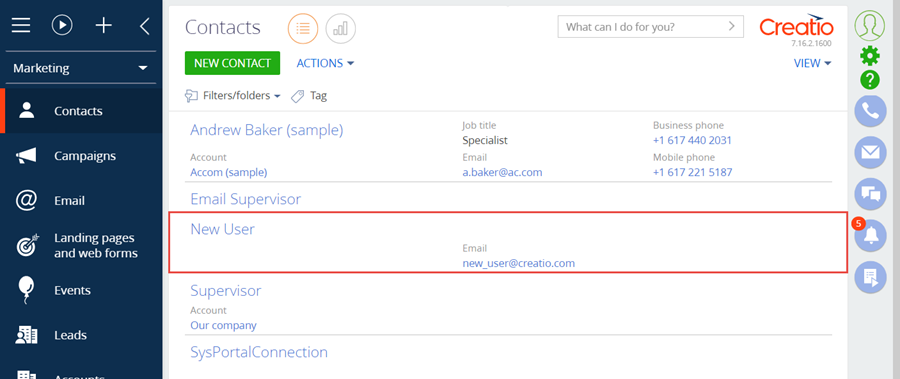Setting up web forms for a custom object
Glossary Item Box

Introduction
Create a custom Creatio object via a landing page web form on a third party website. Learn more about landing pages in the “[Landing pages and web forms] section” article.
The general procedure of creating a custom object via a web form is as follows:
- Register a new landing page type.
- Add an edit page for the web form.
- Map the new landing page type to the created edit page.
- Update the scripts for the web form record page.
- Create and configure a landing page in the [Landing pages and web forms] section.
- Deploy and set up a landing page with a web form.
Tracking website events only works for leads and does not work for custom objects.
Case description
Create a custom [Contact] object using a landing page web form.
Source code
You can download the package with an implementation of the case using the following link.
Case implementation algorithm
1. Register a new landing page type
To do this:
- Open the System Designer by clicking
 . Go to the [System setup] block –> click [Lookups].
. Go to the [System setup] block –> click [Lookups]. - Select the [Landing types] lookup.
- Add a new record.
In the created record, specify (Fig.1):
- [Name] – “Contact”
- [Object] – “Contact.”
Fig. 1. Setting landing page parameters
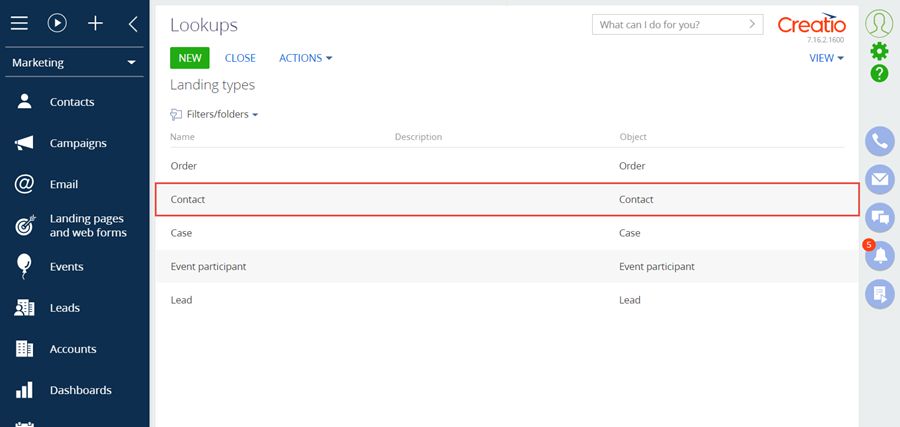
2. Add an edit page for the web form
Run the [Add] –> [Schema of the Edit Page View Model] menu command on the [Schemas] tab in the [Configuration] section of the custom package (Fig. 2). The procedure for creating a view model schema of the edit page is covered in the “Creating a custom client module schema” article.
Fig. 2. – Adding a view model schema of the edit page

Specify the following parameters for the created schema of the edit page view model (Fig. 3):
- [Title] – "ContactGeneratedWebFormPage"
- [Name] – "UsrContactGeneratedWebFormPage"
- [Parent object] – "Edit page, landing."
Fig. 3. Setting up the mini-page view model schema

The complete source code of the module is available below:
// UsrContactGeneratedWebFormPage – unique schema name. define("UsrContactGeneratedWebFormPage", ["UsrContactGeneratedWebFormPageResources"], function() { return { details: /**SCHEMA_DETAILS*/{}/**SCHEMA_DETAILS*/, methods: { /** * @inheritdoc BaseGeneratedWebFormPageV2#getScriptTemplateFromResources * @overriden */ getScriptTemplateFromResources: function() { var scriptTemplate; if (this.getIsFeatureEnabled("OutboundCampaign")) { // ContactScriptTemplate – localizable string name. scriptTemplate = this.get("Resources.Strings.ContactScriptTemplate"); } else { scriptTemplate = this.get("Resources.Strings.ScriptTemplate"); } return scriptTemplate; } }, diff: /**SCHEMA_DIFF*/[]/**SCHEMA_DIFF*/ }; });
Save the schema after making the changes.
Add the ContactScriptTemplate localizable string. Specify <div>Test</div> as the string value (Fig. 4). Learn more about working with localizable strings in the "Source code designer” article.
Fig. 4. Setting up a localizable string

Save the schema after making the changes.
3. Map the new landing page type to the created edit page
To do this, add the record to the [dbo.SysModuleEdit] DB table. Execute the following SQL script to add the record:
-- Parameters of new landing page DECLARE @editPageName nvarchar(250) = N'UsrContactGeneratedWebFormPage'; -- declare the name of the created schema DECLARE @landingTypeName NVARCHAR(250) = N'Contact'; -- the type name of the landing DECLARE @actionCaption NVARCHAR(250) = N'Contact form'; -- declare the type name for the landing in the section when creating a new record -- Set system parameters based on new landing page DECLARE @generatedWebFormEntityUId uniqueidentifier = '41AE7D8D-BEC3-41DF-A6F0-2AB0D08B3967'; DECLARE @cardSchemaUId uniqueidentifier = (select top 1 UId from SysSchema where Name = @editPageName); DECLARE @pageCaption nvarchar(250) = (select top 1 Caption from SysSchema where Name = @editPageName); DECLARE @sysModuleEntityId uniqueidentifier = (select top 1 Id from SysModuleEntity where SysEntitySchemaUId = @generatedWebFormEntityUId); DECLARE @landingTypeId uniqueidentifier = (SELECT TOP 1 Id FROM LandingType WHERE Name = @landingTypeName); -- Adding new Landing page variant to application interface INSERT INTO SysModuleEdit (Id, SysModuleEntityId, TypeColumnValue, UseModuleDetails, CardSchemaUId, ActionKindCaption, ActionKindName, PageCaption) VALUES (NEWID(), @sysModuleEntityId, @landingTypeId, 1, @cardSchemaUId, @actionCaption, @editPageName, @pageCaption)
41AE7D8D-BEC3-41DF-A6F0-2AB0D08B3967 – non-editable identifier of the GeneratedWebForm entity schema in the [dbo.SysSchema] DB table. The ID is relevant for any case featuring adding a landing page for a custom entity.
Clear the browser cache after running the script. As a result, you will be able to add the new [Contact form] landing type in the [Landing pages and web forms] section. However, the script that must be added to the source code of the landing page will not be immediately available on the landing record page (Fig. 6).
Fig. 5. The record list of the [Landing pages and web forms] section

Fig. 6. Landing edit page

4. Update the scripts for the web form record page
The value of the variable contains an escaped HTML string with <script> tags and other information for setting up web form field clusters – the columns for the created entity. This value must be localizable. To do so, execute the following SQL script:
-- Landing edit page schema name DECLARE @editPageName nvarchar(250) = N'UsrContactGeneratedWebFormPage'; -- declare the name of the created schema -- region Scripts' structure DECLARE @sqriptPrefix nvarchar(max) = N'<div style="font-family: "Courier New", monospace; font-size: 10pt;"><script src="http://ajax.googleapis.com/ajax/libs/jquery/1.11.2/jquery.min.js"></script><br><script src="https://webtracking-v01.bpmonline.com/JS/track-cookies.js"></script><br><script src=##apiUrl##></script><br><script><br>/**<br>* Replace the "<span style="color: #0c0cec;">css-selector</span>" placeholders in the code below with the element selectors on your landing page.<br>* You can use #id or any other CSS selector that will define the input field explicitly.<br>* Example: "Email": "#MyEmailField".<br>* If you don"t have a field from the list below placed on your landing, leave the placeholder or remove the line.<br>*/<br>var config = {<br> fields: {<br> '; DECLARE @sqriptDelimiter nvarchar(max) = N'<br> '; DECLARE @sqriptSuffix nvarchar(max) = N'<br> },<br> landingId: ##landingId##,<br> serviceUrl: ##serviceUrl##,<br> redirectUrl: ##redirectUrl##<br>};<br>/**<br>* The function below creates a object from the submitted data.<br>* Bind this function call to the "onSubmit" event of the form or any other elements events.<br>* Example: <form class="mainForm" name="landingForm" onSubmit="createObject(); return false"><br>*/<br>function createObject() {<br> landing.createObjectFromLanding(config)<br>}<br>/**<br>* The function below inits landing page using URL parameters.<br>*/<br>function initLanding() {<br> landing.initLanding(config)<br>}<br>jQuery(document).ready(initLanding)<br></script></div>'; -- endregion -- region Scripts' variables DECLARE @sqriptNameColumn nvarchar(max); -- declare column variables to map to the landing DECLARE @sqriptEmailColumn nvarchar(max); DECLARE @scriptResult nvarchar(max); -- endregion -- Adding entity columns. SET @sqriptNameColumn = N'"Name": "<span style="color: #0c0cec;">css-selector</span>", // Name of a contact'; SET @sqriptEmailColumn = N'"Email": "<span style="color: #0c0cec;">css-selector</span>", // Email'; -- Concat result scripts. SET @scriptResult = @sqriptPrefix + @sqriptNameColumn + @sqriptDelimiter + @sqriptEmailColumn + @sqriptSuffix; -- Set new localizable scripts value for resource with name like '%ScriptTemplate' UPDATE SysLocalizableValue SET [Value] = @scriptResult WHERE SysSchemaId = (SELECT TOP 1 Id FROM SysSchema WHERE [Name] = @editPageName) and [Key] like '%ScriptTemplate.Value'
In the Adding entity columns block, add the names of the entity columns to be filled with the values from the web form.
Replace the double quote (") and space ( ) characters with the " and HTML character entity references.
Add the (@scriptVariableNameColumn) variable and concatenate it to scriptResult for adding a field.
If the values of other fields (except for Name and Email) are required after completing the setup, re-run the script from this paragraph after registering all of the required columns, including the existing ones, in the Adding entity columns block. When the script is re-run, the settings created earlier are updated.
After the script execution completes, open the schema created in the configuration and re-save it to re-save the resources as well. As a result, when selecting [Contact form] in the [Landing pages and web forms] section, Creatio will display the landing edit page (Fig. 6) combined with the script to copy to the landing page source code.
Fig. 7. Landing edit page
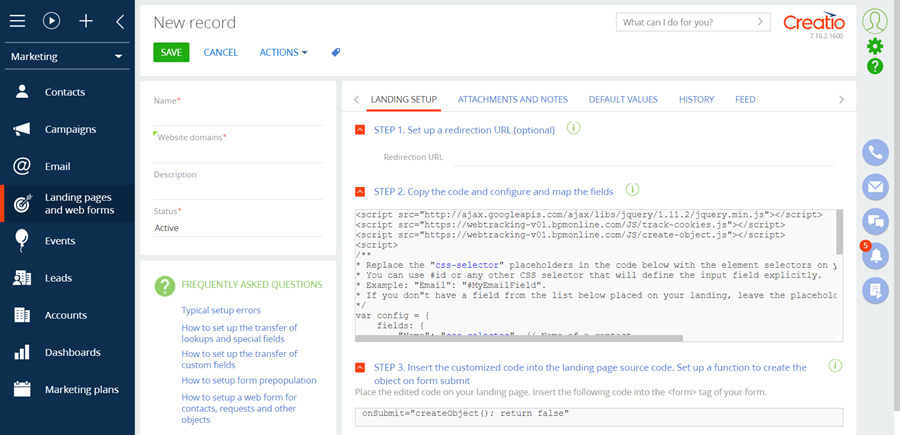
The script contains the config configuration object, which has the following properties defined:
- fields – contains the Name and Email properties. Their values must match the selectors of the id attributes of the corresponding field of the web form.
- landingId – the landing page ID in the database.
- serviceUrl – the URL of the service to which the web form data will be sent.
- onSuccess – the handler function to process a successful contact creation. Optional property.
- onError – the handler function to process a contact creation error. Optional property.
The configuration to be formed is displayed below.
var config = { fields: { "Name": "css-selector", // Contact name "Email": "css-selector", // Email name }, landingId: "b73790ab-acb1-4806-baea-4342a1f3b2a8", serviceUrl: "http://localhost:85/0/ServiceModel/GeneratedObjectWebFormService.svc/SaveWebFormObjectData", redirectUrl: "" };
5. Create and configure a landing page in the [Landing pages and web forms] section
To do this, go the [Landing pages and web forms] section and click [Contact form]. Learn more about adding [Landing pages and web forms] records in the “Adding new records in the [Landing pages and web forms] section” article.
In the created record, specify (Fig. 8):
- [Name] – “Contact”
- [Website domains] – "http://localhost:85/Landing/LandingPage.aspx"
- [Status] – "Active".
Fig. 8. Landing edit page

Save the page to apply the changes.
6. Deploy and set up a landing page with a web form
Create a landing page with a web form using HTML markup in any text editor. Learn more about creating a landing page and adding the landing script in the “How to connect your website landing page to Creatio” article.
To register contact data sent via the web form in Creatio, add the following fields (<input> HTML element) to the source code of the landing page:
- Contact name.
- Contact email.
Specify the name and id attributes for each field.
To create a new [Contact] object when sending web form data to Creatio, add the JavaScript code to the landing page. Copy the source code from the [STEP 2. Copy the code and configure and map the fields] field on the landing record page (fig 8.).
The config object is passed as an argument of the createObject() function, which is executed upon submitting the web form.
Ensure that the createObject() function is called upon submitting the web form. To do this, add the onSubmit="createObject(); return false" attribute to the <form> element. You can retrieve the required attribute value from the [STEP 3. Insert the customized code into the landing page source code. Set up a function to create the object on form submit] field on the landing edit page (Fig. 8).
The complete source code of the landing page is available below:
<!DOCTYPE html> <html> <head> <meta charset="utf-8"><!--ШАГ 2--> <!--Сopу this part from the STEP 2 field of the landing edit page--><script src="http://ajax.googleapis.com/ajax/libs/jquery/1.11.2/jquery.min.js"></script> <script src="https://webtracking-v01.bpmonline.com/JS/track-cookies.js"></script> <script src="https://webtracking-v01.bpmonline.com/JS/create-object.js"></script> <script> /** * Replace the "css-selector" placeholders in the code below with the element selectors on your landing page. * You can use #id or any other CSS selector that will define the input field explicitly. * Example: "Email": "#MyEmailField". * If you don"t have a field from the list below placed on your landing, leave the placeholder or remove the line. */ var config = { fields: { "Name": "#name-field", // Name of a contact "Email": "#email-field", // Email }, landingId: "b73790ab-acb1-4806-baea-4342a1f3b2a8", serviceUrl: "http://localhost:85/0/ServiceModel/GeneratedObjectWebFormService.svc/SaveWebFormObjectData", redirectUrl: "", onSuccess: function(response) { window.alert(response.resultMessage); }, onError: function(response) { window.alert(response.resultMessage); } }; /** * The function below creates a object from the submitted data. * Bind this function call to the "onSubmit" event of the form or any other elements events. * Example: <form class="mainForm" name="landingForm" onSubmit="createObject(); return false"> */ function createObject() { landing.createObjectFromLanding(config) } /** * The function below inits landing page using URL parameters. */ function initLanding() { landing.initLanding(config) } jQuery(document).ready(initLanding) </script><!--ШАГ 2--></head> <body> <h1>Landing web-page</h1> <div> <h2>Contact form</h2> <form method="POST" class="mainForm" name="landingForm" onSubmit="createObject(); return false">Name:<br><input type="text" name="Name" id="name-field"><br> Email:<br><input type="text" name="Email" id="email-field"><br><br><br><input type="submit" value="Submit"> </font> </form> </div> </body> </html>
Open the landing page Specify the values for the created contact (Fig. 9):
- [Name] — "New User"
- [Email] — "new_user@creatio.com".
Fig. 9. Landing page
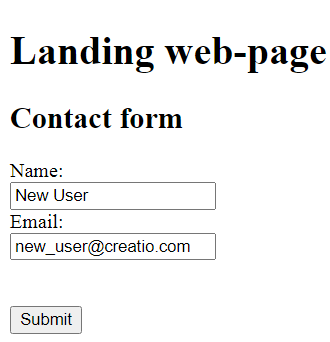
Click [Submit] to create the contact.
The contact from the landing page will only be added if the domain of the landing page is specified in the [Website domains] field on the landing record page.
If you place the page on the local server available via the “localhost” reserved domain name (as specified in the landing page setup, Fig. 8), then the script for creating a contact from the landing page will work correctly (Fig. 10).
Fig. 10. A message about successful data addition
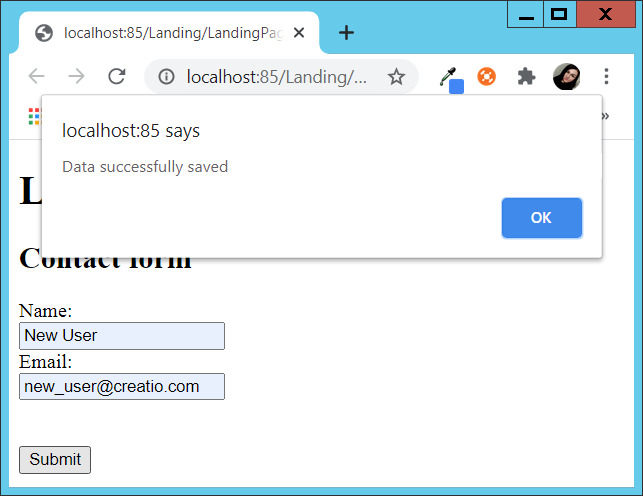
As a result, Creatio will create a contact with the specified parameters (Fig. 11).
Fig. 11. Automatically created contact
